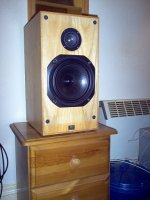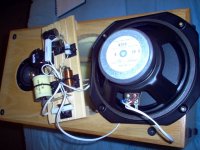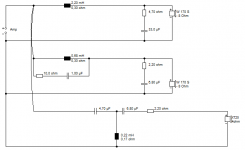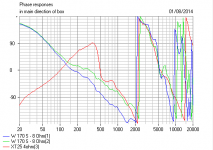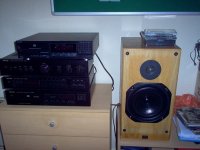Ok. I haven't got all day but here's a few to be getting on with:
Kef coda 7
Kef coda 8
Mission M70
Linn Kan Mk2 (can sound rough with the wrong electronics but so can most speakers)
Dynaudio audience 52
Dynaudio contour 1.3se
Proac studio 100
JPW AP2
I've owned and lived with all these speakers and none had spitty or sizzly treble.
Kef coda 7
Kef coda 8
Mission M70
Linn Kan Mk2 (can sound rough with the wrong electronics but so can most speakers)
Dynaudio audience 52
Dynaudio contour 1.3se
Proac studio 100
JPW AP2
I've owned and lived with all these speakers and none had spitty or sizzly treble.
Yes, ALL soft domes are broken!
Twaddle. They have their positive attributes and downsides, like everything else and to make a blanket assertion of that kind is to put it mildly unscientific and ignoring a vast array of rather important factors such as FR, impedance & distortion performance in order to promote a single factor, the basis of which appears to be a single Boxsim comparison & a commercial interview in Stereophile.
That's what Clausen has discovered by LISTENING!
Really? I thought the gentleman had found that he doesn't care for a particular speaker with a particular filter / tweeter. I hadn't noticed that he had experimented with a extensive number of soft-dome tweeters with a wide variety of different filters and come to that conclusion. Perhaps you could point us to the posts in this thread where these tests were made.
So what are we seeing here with my comparison of an XT25, using imported FRD and ZMA files in Boxsim, and a soft dome? EXACTLY what Robin Marshall is talking about. Game, Set and Match to Robin Marshall I'd say.
I wouldn't. The interview gives Robin Marshall's opinion. I see no measurements, and a single, selected and simulated (but untested) example doth not automatically make general applicability. Black swan hypothesis. Nor will it be universally accepted that all soft dome tweeters 'spit and sizzle'. That is an entirely subjective comment, and innumerable people the world over, including many extremely able designers will completely reject that as a description of all soft-dome tweeters.
With that said, as an aside, I agree with some of his views re cone / inverted dome tweeters, which can offer certain advantages.
But hey, you stick to your frequency plots.
I do believe I will, along with their distortion & impedance etc. behaviour, rather than ignoring these, since in my experience they are rather important.
Last edited:
System, have you used a number of good soft domes, Well Implemented? Is that what you hear or are you simply basing you view off of someone else's views?
I've built the nomex164 and used the D2608/9130 in another design. I can say equivocally that it doesn't exhibit the traits your railing on about. It's a well built, solid performer, period. It can be made to sound like ****, no doubt about it, but so can any other tweeter. Your are saying that any speaker built with a soft dome sucks, no questions asked, um what? That's not science, as you call it, and no scientist would make that kind of blanket statement after looking at one graph (which is of little use for making your point) and reading an article by someone that may very well have an ulterior motive for writing it.
Anyways, if you are trying to tell clausen that his speaker sucks because of the tweeter and if he drops in your tweeter, all will be well, then you at least need to run the sims and help him with all the xo changes that will be needed because obviously it will not simply drop in with no issues.
Now, considering that he's changed to a 3.3/10 ohm lpad and whacked the last octave down too, I seriously doubt that the tweeter is the problem. It must 5db or more below the rest of the range by now. I would be looking at the mid, room, placement, power response, absolute spl needed to fill his room, etc.
I've built the nomex164 and used the D2608/9130 in another design. I can say equivocally that it doesn't exhibit the traits your railing on about. It's a well built, solid performer, period. It can be made to sound like ****, no doubt about it, but so can any other tweeter. Your are saying that any speaker built with a soft dome sucks, no questions asked, um what? That's not science, as you call it, and no scientist would make that kind of blanket statement after looking at one graph (which is of little use for making your point) and reading an article by someone that may very well have an ulterior motive for writing it.
Anyways, if you are trying to tell clausen that his speaker sucks because of the tweeter and if he drops in your tweeter, all will be well, then you at least need to run the sims and help him with all the xo changes that will be needed because obviously it will not simply drop in with no issues.
Now, considering that he's changed to a 3.3/10 ohm lpad and whacked the last octave down too, I seriously doubt that the tweeter is the problem. It must 5db or more below the rest of the range by now. I would be looking at the mid, room, placement, power response, absolute spl needed to fill his room, etc.
Quite easy to follow really. The SC10N soft dome has a ghastly second resonance around 6kHz, represented by an S-shaped kink in the phase curve. Ideally a phase curve will be more or less a straight line. You can see that a 6" woofer has a few issues too. Another way to look at the kinks in the phase is the slope of the bends correspond to group delay. Above 6kHz, it has lost all linearity.Please explain how to read the phase plots you are posting.
The non-ferrofluid XT25 ring radiator does much better, with no significant resonances or energy storage whatsoever. Almost perfect straight line. In fact a ring radiator has much in common with a cone tweeter, even down to needing a third order filter to work well. Significantly, a ring radiator pins the troublesome floppy centre of the dome rigidly, thus curing most of the resonance problems.
Nobody has mentioned one other rather obvious thing about the D2608 tweeter, is that it is a largish 30mm dome, which means the usual problems kicked in earlier and required some rolloff.
A flat frequency response says nothing about whether a speaker will sound good. What is interesting to me, is that some drivers can convey MUSICAL INFORMATION very well. Unfortunately, a soft dome does very little above 6kHz in that respect whether you roll it off with damping, or let it spit and sizzle in the usual way.
Truly one of my more interesting posts, IMO. I don't tell people their speakers are rubbish to make myself popular! 😀
Attachments
System7,
I find your posts are hilarious, i was taking you seriously before, but reading your posts about soft dome tweeters made me realised that you may not know about speakers after all.
Cheers
Henry
I find your posts are hilarious, i was taking you seriously before, but reading your posts about soft dome tweeters made me realised that you may not know about speakers after all.
Cheers
Henry
System7,
I find your posts are hilarious, i was taking you seriously before, but reading your posts about soft dome tweeters made me realised that you may not know about speakers after all.
Cheers
Henry
+1
I find your posts are hilarious, i was taking you seriously before, but reading your posts about soft dome tweeters made me realised that you may not know about speakers after all.
Cheers
Henry
+1
In fact a ring radiator has much in common with a cone tweeter, even down to needing a third order filter to work well.
Tell that to Zaph, and all those who have built or heard his ZD5 (acoustic LR2 with the XT25 ring radiator).
Significantly, a ring radiator pins the troublesome floppy centre of the dome rigidly, thus curing most of the resonance problems.
Actually, if you talk to some tweeter designers, you'll find many complain about resonance issues in domes, period. But these are not always about a lack of strength at the centre. There are other engineering factors too, such as the physical coupling location of the VC.
Nobody has mentioned one other rather obvious thing about the D2608 tweeter, is that it is a largish 30mm dome
An interesting point actually. Sd is a touch smaller than many nominal 1in models (Seas usually list at 7.5cm^2 for e.g.). 26mm VC, 7cm^2 Sd stated. I suspect they're including part of the surround in that, although I don't have a pair to hand to take a tape measure to.
A flat frequency response says nothing about whether a speaker will sound good.
True, but assuming distortion performance is low, it is accurately reproducing what is fed into it. Whether everybody actually likes that is another matter; likewise it is not always appropriate / viable for a given set of design criteria / requirements -the 'BBC dip' being a good example.
What is interesting to me, is that some drivers can convey MUSICAL INFORMATION very well. Unfortunately, a soft dome does very little above 6kHz in that respect whether you roll it off with damping, or let it spit and sizzle in the usual way.
True re the first part, but sans any defining criteria, purely subjective. The second also being unqualified & therefore subjective opinion only.
Last edited:
"Truly one of my more interesting posts, IMO. I don't tell people their speakers are rubbish to make myself popular!"
..you can say that again 🙂
..you can say that again 🙂
Going back to the original problem. I don't believe for one minute that it's caused by the tweeter (assuming it's not faulty). If that LCR has notched a peak at 12k and improved the sound, then it has to be something wrong with the electronics.
I can create a peak at 12k with my own speakers and it just sounds a bit too airy but not in any way nasty.
I'd try a different amp and source. Perhaps get a cheap t-amp off ebay or borrow one.
I can create a peak at 12k with my own speakers and it just sounds a bit too airy but not in any way nasty.
I'd try a different amp and source. Perhaps get a cheap t-amp off ebay or borrow one.
Going back to the original problem. I don't believe for one minute that it's caused by the tweeter (assuming it's not faulty). If that LCR has notched a peak at 12k and improved the sound, then it has to be something wrong with the electronics.
I can create a peak at 12k with my own speakers and it just sounds a bit too airy but not in any way nasty.
I'd try a different amp and source. Perhaps get a cheap t-amp off ebay or borrow one.
That's a very fair point, well made. Amplifier transistor output bias can wander and lead to distortion at HF. It's not hard to get the amp manual and trim it if necessary with a voltmeter and a trimmer or screwdriver to the potentiometers. My Class AB Rotel had wandered from the specified 0.04mV to 0.048mV when warm and sounded quite harsh.
Bias is a bit unpredictable, and can be a problem with a warm amp. I suppose good ventilation must help keep it stable too.
System, have you used a number of good soft domes, Well Implemented? Is that what you hear or are you simply basing you view off of someone else's views?
I've built the nomex164 and used the D2608/9130 in another design. I can say equivocally that it doesn't exhibit the traits your railing on about. It's a well built, solid performer, period. It can be made to sound like ****, no doubt about it, but so can any other tweeter. Your are saying that any speaker built with a soft dome sucks, no questions asked, um what? That's not science, as you call it, and no scientist would make that kind of blanket statement after looking at one graph (which is of little use for making your point) and reading an article by someone that may very well have an ulterior motive for writing it.
Anyways, if you are trying to tell clausen that his speaker sucks because of the tweeter and if he drops in your tweeter, all will be well, then you at least need to run the sims and help him with all the xo changes that will be needed because obviously it will not simply drop in with no issues.
Now, considering that he's changed to a 3.3/10 ohm lpad and whacked the last octave down too, I seriously doubt that the tweeter is the problem. It must 5db or more below the rest of the range by now. I would be looking at the mid, room, placement, power response, absolute spl needed to fill his room, etc.
My least favourite speaker:
An externally hosted image should be here but it was not working when we last tested it.
Morel soft dome on a BW3.
Monacor cone tweeter, below, works much better. Truly musical and revealing.
Attachments
That doesn't exactly prove that all soft domes suck, but I guess at least you've listened to one, that's good.
I've used a couple of mid tweeter type speakers in the past like the FF85wk and even though I like it, I like a real tweeter better, be it dome, ring or amt style. Their off axis performance and the need to eat up interior volume for it's own enclosure are enough for me to stick with domes and the like.
Maybe this is all a bit more subjective than you want to admit rather than science.
I've used a couple of mid tweeter type speakers in the past like the FF85wk and even though I like it, I like a real tweeter better, be it dome, ring or amt style. Their off axis performance and the need to eat up interior volume for it's own enclosure are enough for me to stick with domes and the like.
Maybe this is all a bit more subjective than you want to admit rather than science.
For sure, soft domes are the WORST tweeter in town in my experience. I think I'd prefer a good metal jobbie like the SEAS 22TAF/G. I've already done some rough and ready modelling of the Nomex 164 with XT25 reusing some existing components. Tweeter attenuation is select on test anyway, but this won't be a million miles away. I'd use the double magnet XT25 since people say it's better. 🙂
Ghastly impedance, but what can you do with such a design...LOL
Ghastly impedance, but what can you do with such a design...LOL
Attachments
Last edited:
For sure, soft domes are the WORST tweeter in town in my experience. I think I'd prefer a good metal jobbie like the SEAS 22TAF/G. I've already done some rough and ready modelling of the Nomex 164 with XT25 reusing some existing components. Tweeter attenuation is select on test anyway, but this won't be a million miles away. I'd use the double magnet XT25 since people say it's better. 🙂
Ghastly impedance, but what can you do with such a design...LOL
Not bad, at least you're giving him something real to work with, well from nfg graphs anyways. What's up with that mondo peak/knee @ 5K? And it almost looks like the lower woofer could do with a notch too; maybe .47 and 10 ohm. I thought the xt25 had a smooth response, is that really what it looks like on an 8" baffle?
Also, your sensitivity looks a bit low. That would be about 8-9 db baffle steep if I'm not mistaken with the tweeter reduced even further
satx, I did say rough and ready modelling. The particular XT25 I modelled was the XT25SC30-04 with ZMA and FRD files from Zaph Audio. 😀
The Nomex bass driver will roll off faster being low inductance too. These are mere details, and I'd prefer 3.9uF at the tweeter filter, but 4.7uF is not far off. As is closed box or reflex. I've kept with Troels' bass design.
But the XT25 always looks worse on frequency response than it sounds. Our late, great moderator Tinitus always liked the XT25.
Completely off-topic really, but I'm evaluating a classic early 1987 Sony CD player which just needed a new rubber drive belt to kick it into life. The CDP-M77 complete with 18 bit DAC and 8 bit oversampling. Some classic chips in there, and it sounds remarkably detailed.
CD players tended to get worse as time went on. Mainly because genuine ladder DACs were expensive to make and trim. So I like retro. 😱
The Nomex bass driver will roll off faster being low inductance too. These are mere details, and I'd prefer 3.9uF at the tweeter filter, but 4.7uF is not far off. As is closed box or reflex. I've kept with Troels' bass design.
But the XT25 always looks worse on frequency response than it sounds. Our late, great moderator Tinitus always liked the XT25.
Completely off-topic really, but I'm evaluating a classic early 1987 Sony CD player which just needed a new rubber drive belt to kick it into life. The CDP-M77 complete with 18 bit DAC and 8 bit oversampling. Some classic chips in there, and it sounds remarkably detailed.
CD players tended to get worse as time went on. Mainly because genuine ladder DACs were expensive to make and trim. So I like retro. 😱
Attachments
Last edited:
I must be thinking of a different one that was so smooth
Take a look at the overall sensitivity though
Take a look at the overall sensitivity though
The main thing is the XT25 would need to have ENOUGH sensitivity. It's not my current project, so we'd just hope for the best on sensitivity.
I think it'll be OK. 6" bass is not "Le dernier Cri" in loudness. Adding some resistance and attenuation will help raise top end impedance for sure.
I don't know quite how I have been led up this particular path. I'd never fancy a speaker like this Nomex 164 at all. Much better options about. 🙂
I think it'll be OK. 6" bass is not "Le dernier Cri" in loudness. Adding some resistance and attenuation will help raise top end impedance for sure.
I don't know quite how I have been led up this particular path. I'd never fancy a speaker like this Nomex 164 at all. Much better options about. 🙂
Yes, looking at the plot it looks to be about 90db max. Why try to shoehorn that tweeter in there if it's not ideal. That really gives you very little if any room to finesse the FR or raise the impedance considering it's 4 ohm.
Anyways, I seriously doubt the the HDS tweeter in the Nomex is the problem and I don't think replacing it with the xt25 is the solution. I would look room, wiring mishap, damaged component, power response/xo point, and electronics/source. In that order.
Anyways, I seriously doubt the the HDS tweeter in the Nomex is the problem and I don't think replacing it with the xt25 is the solution. I would look room, wiring mishap, damaged component, power response/xo point, and electronics/source. In that order.
If I've discovered some "Secrets" of a good sounding speaker, they all involve using Zobels or near-Zobel impedance correction.
Why? Because they damp the voicecoil and cone at high frequency and control resonances. IF the chassis is good enough.
Notches are horrible double-edged swords that treat a particular frequency and phase problem, but cause peaks and problems elsewhere.
People have this odd notion that simpler filters work better, but really, for that lovely darkness between notes and smoothness, you are better using a larger number of distributed elements, say 4, to give some serious rolloff.
Well, that's my current thinking. That and BW3 with the odd 90 degree phase alignment that seems to work so well to fill the room in regular speakers and MTTM. 😎
Why? Because they damp the voicecoil and cone at high frequency and control resonances. IF the chassis is good enough.
Notches are horrible double-edged swords that treat a particular frequency and phase problem, but cause peaks and problems elsewhere.
People have this odd notion that simpler filters work better, but really, for that lovely darkness between notes and smoothness, you are better using a larger number of distributed elements, say 4, to give some serious rolloff.
Well, that's my current thinking. That and BW3 with the odd 90 degree phase alignment that seems to work so well to fill the room in regular speakers and MTTM. 😎
- Home
- Loudspeakers
- Multi-Way
- Peerless HDS Tweeter too harsh, (Nomex 164)

